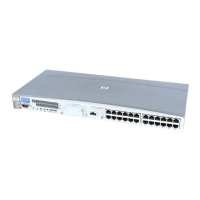This option is not supported on Novell NetWare. However, it is possible to
uncompress files that were compressed with this option using older versions of
Data Protector.
-encode [aes256]
Instructs the General Disk Agent to write data to media in encoded format.
If the aes256 option is specified, data is written to media in encrypted format,
using the Advanced Encryption Standard (AES) algorithm.
-load{low | medium | high}
Specifies the level of network traffic generated by a session during a time period.
High level generates as much traffic as allowed by the network, resulting in a
faster backup. Low level has less impact on the network performance, but results
in a slower backup. By default, this option is set to high.
-crc
Instructs the General Media Agent to write a CRC checksum at the end of every
block on the medium. If this option is used, you can later verify the CRC checksum
on the medium by using the omniver command.
-no_monitor
By default, the command monitors the session and displays the status of the
session during the session. If this option is used, the SessionKey is displayed and
the command is disconnected from the session.
-keepcatalog{weeks n | days n | until Date}
This option specifies file catalog retention time. If you do not want to save the
file catalog at all, use the -no_log option. By default, this option is set to the
same value as specified by the protection option.
-variable VariableName VariableValue
This option lets you specify a variable name and its value for proper operation
of some platforms and integrations, for example, for backing up and restoring
data on MPE/iX System. Setting user definable variables (a variable name and
its value) enables flexible operation on some platforms and integrations with
Data Protector. The list of variables and their values that are configurable with
Data Protector is dynamic and comes with Data Protector patches.
FILESYSTEM_OPTIONS
-trees TreeList
Specifies the trees to be included in the backup. If this option is not used, the
filesystem is backed up from the mount point level downwards. When specifying
several trees, separate each Tree with a space. Tree must start with a /. Note
that when specifying trees on UNIX systems, the complete tree must be specified
including the mountpoint, whereas on Windows systems, trees must be specified
Command line interface reference 59

